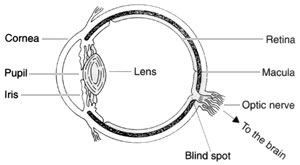  |
|
  |
|
| Eye Sight Examination What is Nastagmus? Nastagmus is a involuntary movement of the eyes - usually from side to side, but sometimes the eyes oscillate up and down of even in a circular motion. Most people with nastagmus have vision which is much worse than average - well below what is considered to be short sighted. Many people can register as partially sighted and a small number can register as blind. Who is affected? Nastagmus which appears in the first six
month if life called 'early onset nastagmus or 'congenital' or infantile
'nastagmus'. The condition may also develop late in life when the
term 'acquired nastagmus' is used. What cause Nastagmus? Nastagmus is early childhood may be caused by a defect in the eye or the visual pathway from the eye to the brain. It occurs in a wide range of eye disorders of childhood such as cataract, glaucoma, some disorders of the retina ad albinism. It may also be found in children who have multiple disability such as Down's Syndrome. |
The Types of Diseases Found:
|
Many children with Nastagmus have no
eye, brain or other health problems. In this case the condition
is called 'congential idiopathic Nastagmus' or 'idiopathic infantile
nystagmus' meaning that the condition is observed, or starts, early
in life and the cause is unknown. Several types of nastagmus can be inherited. To find out the chances of someone passing on Nystagmus to the next generation, a specialist must first make an accurate diagnosis of the underlying condition. It may then be necessary to consult a clinical geneticist for detailed information and counselling. Acquired nystagmus which develops later in life may be a symptom of another condition such as a stroke, multiple scleriosis or even a blow to the head. There are many other causes. Nystagmus is not infectious or contagious. Because nystagmus may be the first sign of serious disorder of the eye or brain, it is vital that when Nystagmus first develops the child or adult in referred to an ophthalmologist (eye specialist) or a neurologist. What treatment is available? Nystagmus cannot be cured, but there are several treatments which can help. Glasses and Contact lenses do not correct Nystagmus, although they may help a little & should certainly be worn to correct other sight problems. A child or adult may be diagnosed as being 'short sighted' as well as having nystagmus. Long or short sightedness occur because the eye itself is not exactly the right shape for focusing.
Medical researchers have exploded ways of trying to reduce the nystagmus by making the patient aware of the eye movement and encouraging them to control it. These techniques rely on visual or audio signals (known as bio-feedback) to the patient. For example, the patient might listen to an electronic signal which goes higher when the eye movement is greater. Some people have said that they benefit from this type of treatment. However, the evidence is not conclusive and many question remain unanswered such as: 'Do any possible benefits last?' Interest in Nystagmus among vision scientists is growing. However a lot of basic research is needed to understand the condition better and progress is likely to be measured in decades rather than years. |
